-
Posts
11,151 -
Joined
Content Type
Profiles
Forums
Store
Help Articles
Posts posted by slkinsey
-
-
Excerpted from this thread on an Ideas in Food dinner:
Getting used to another kitchen can be daunting, though I think Alex and Aki settled into this one rather quickly and easily. Another special piece of equipment they brought with them was a set of Himalayan pink salt slabs that they would grill scallops on.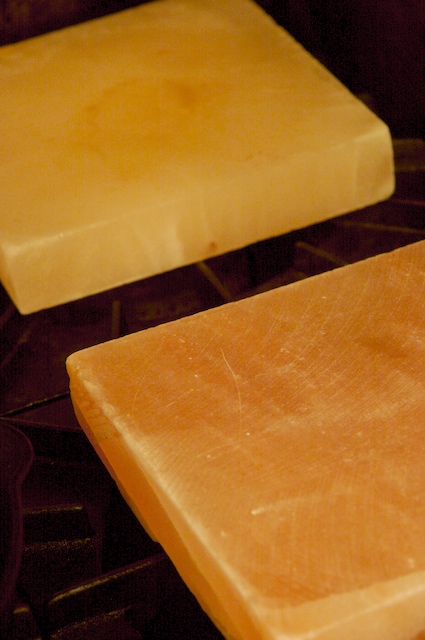 The kitchen started to get fired up.
The kitchen started to get fired up.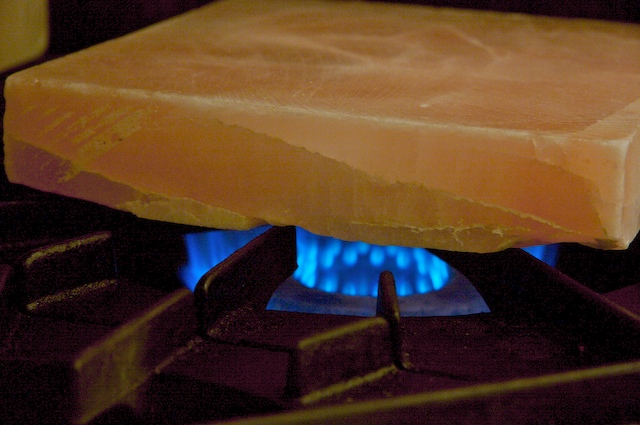
I first became aware of these salt blocks and the myriad of potential uses for them at David Burke's Demonstration at the Starchefs ICC. Ironically Aki and Alex missed that demo as they were busy with the Pacojet Competition at the same event.
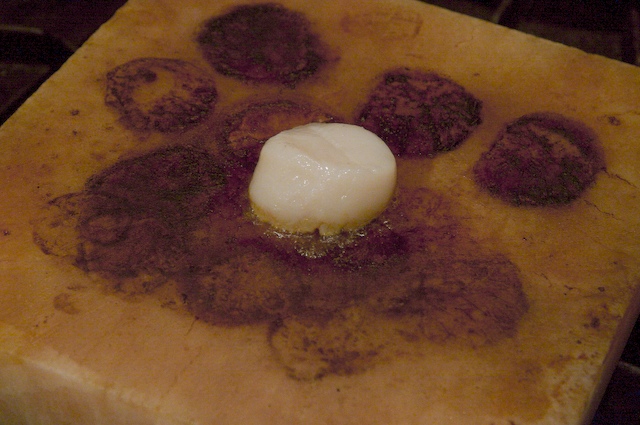
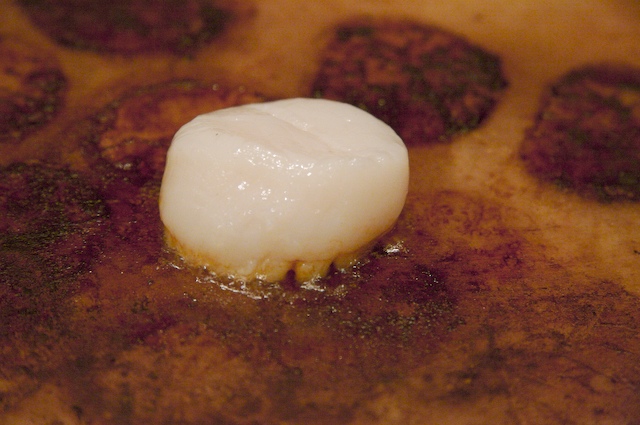
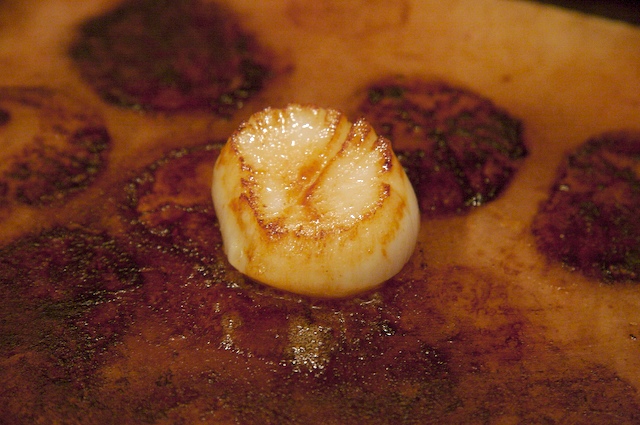
Scallop searing in butter on the salt griddle.
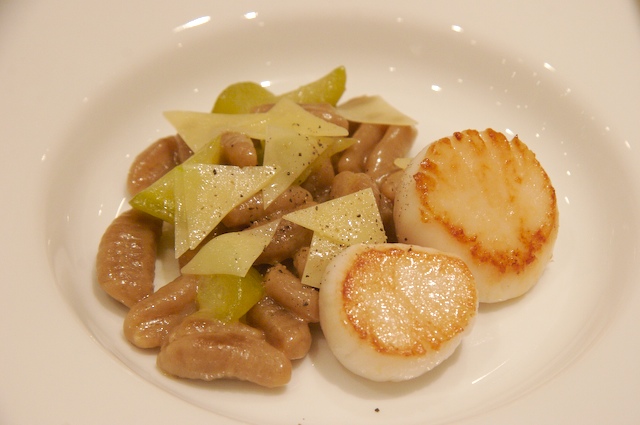
Coffee Cavatelli, salt seared scallops, cucumber-walnut, gruyere
The scallops were sweet and delicious, but I can't say that I noticed any real difference from other nicely seared scallops. The cavatelli were made using freeze-dried coffee, a process that Alex said that had grown out of an email conversation that he had with Wylie Dufresne over how instant coffee was made. Wylie noted that he had been making gnocchi and spaetzle with instant coffee. The compressed cucumber-walnut by itself was interesting, but not of particular interest. The cavatelli, cucumber and gruyere together, however, were synergistic to the point that they were more than interesting. They were also delicious, especially with the beautiful scallops. We stayed with the reisling through this course.
-
Well, the use of high proof grain alcohol makes a pretty big difference as well.
But, especially when what you want to extract is a volatile oil, it's not like the herb or plant or whatever has infinite amounts of the stuff. Eventually you're going to run into several problems. First is that you've already extracted as much of the stuff you want as it is possible to extract, and any longer time will not fundamentally increase extraction of that stuff. Volatile oils extract pretty darn quickly in high proof grain alcohol. Second is that you may very well start infusing in some slower-extracting parts of the herb. And these may not be the parts that you want.
So, for example, let's say you have something you're trying to extract into alcohol, and you feel like you have to walk a very fine line between getting enough flavor and developing unpleasant off flavors. The solution is to do multiple shorter-length extractions into the same alcohol.
-
One other possibility would be to do something like roasting some peaches, crushing the kernels, and infusing them into something like Laird's bonded.
-
my point was that where Alice Waters is a self-righteous scold Sandy Lerner is an effective, low-key presenter of the humane-farming message -- a mode of interaction that is far more likely to make converts.
just as i suspected this is mostly about the tone, and not the message. it's really important not to seem bossy or condesending.
if you are a woman.
Yes, I think many people have been arguing that much of it is the tone, as well as the extent to which some of her specifics (e.g., things like snarks about people who choose to spend their money on two pairs of Nikes instead of organic lamb from the farmer's market) also seem condescending, judgmental, unrealistic or disrespectful of the priorities other people may have. Meanwhile, while I do think it's true that women face challenges in expressing certain arguments in certain ways (this was extensively hashed over during the Democratic primaries, and there is plenty of research to support gender-influenced differences in the way public figures are perceived) I'm not convinced that a man who seemed bossy and condescending while wagging a finger at people who don't buy heirloom tomatoes or whatever would be received any better.
-
Lovage is all caramel, cedar, and oak on the nose, and the same with a more pronounced woody bitterness on the tongue. Another winner.
This is interesting. I really like lovage. Do you know whether this was the root, or the stem and leaves, or the seeds of the lovage plant? I ask because lovage leaves and stems have a kind of herbal celery flavor that is nothing like what you describe.
This brings me to another thought about bitters in general, which is the idea of perhaps including a fresh infusion as part of the recipe. For example, you could take fresh lovage leaves, infuse them into grain alcohol, steep, remove, add more leaves, steep, remove, add more leaves, etc. until the alcohol became saturated with the lovage oils -- and then you could use the intense lovage infusion in your bitters. As an added bonus, this kind of infusion into grain alcohol will maintain its intense green color more or less indefinitely. If you kept the bitters at a high proof, you could have a great color.
-
Some questions for the data-loggers:
1. Am I correct in assuming that these are setups which do not have active circulation?
2. To what extent are you testing for consistency of temperature throughout the water bath?
3. Are any of the data-loggers seeing accuracy and consistency markedly better than what blackp with their non-circulating PID setups?
4. To what extent does the recorded temperature accord with the tempurature displayed by the PID?
-
The only luck I've ever had with shredded chicken breast is to poach it very lightly until just done (these days I am more likely to cook sous vide to 60.5C), then chill in an ice bath, shred, and then fold the shredded breast meat into whatever hot or cold condiment you want to have with the meat.
So, for example, if I were going to do this hot with a mole sauce, I'd heat the mole, fold in the cold shredded chicken breast meat, get it barely up to temperature and serve immediately. If I were going to do something that spend time in the oven, I'd probably just combine the ingredients at room temperature and finish in the oven.
-
Well, yes you can. But you don't really want to eat breast meat that's been simmering for an hour. It'll be cottony and dry as a bone.
-
And use thighs, not breasts.
-
Re a Lewis Bag: 15 bucks will get you one of these.
-
I do think that overworking is likely the culprit. Unfortunately, if you're buying pre-ground there is very little you can do about this, because it might already be overworked before you even get the meat. Do you ever notice that this characteristic problem is particular to burgers made from a particular batch of meat and not from another? Anyway, if you're salting the ground meat and then mixing it with your hands to incorporate the salt, I would think that overworking might be a problem. Better to incorporate the salt when the meat is ground, or only on the surface of the burgers. One thing you might consider doing if you have to stick with preground meat is salting the meat and adding whatever else you might like to add (a little extra fat in the form of butter or bacon fat is a good idea, I think) and then running this all through the grinder again. After that, the ground meat should be sufficiently loosened up and you should work it as little as possible.
One thing that you might consider doing if you make a lot of burgers is creating a form. This would be something like an open ring with the diameter and thickness that you want for your burger. Then you put in the proper weight of ground beef, press down from the top with something flat that's larger than the form, and you end up with just the amount of compression that you want (preferably just enough to hold the burger together) with minimal working of the meat.
-
Tuscan Dairy Farms, one of the main supermarket brands we see here in NYC, says that "our milk comes from over 200 local farms throughout New York, New Jersey and Pennsylvania, and our products are available in supermarkets, convenience stores and food service outlets throughout the 5 boroughs of New York City, Long Island, and the northern half of New Jersey."
-
But you don't want to bruise the mint...
-
Isn't gossip by its very nature not going to be 100% accurate and reliable? As in "a rumor or report of an intimate nature"?
If you have a site that runs gossip, you're going to be wrong about things from time to time. The thing to do is own up to it to your public, admit you made a mistake and move on. Or get out of the gossip business.
Of course we all prefer the good, juicy gossip to be accurate. But it never will be completely so.
-
I am also with rancho_gordo. Which is to say, I am for "local when it makes sense and not-local when that makes sense" with an understanding that different populations and geographical areas will be able to pursue slocal foods to a different extent, and respect for the fact that non-slocal can sometimes mean "better for the environment"; I am for "responsible agriculture without necessarily adhering to organic dogma; and I am for some combination of more-intensive and less-intensively raised meat (again, respecting the various exigencies of feeding the population as well as the true ecological realities of carbon footprints, etc.), preferably as humanely as practically feasible.
But this is a non-absolutist agenda. It's not one that appears to insist that it is ecologically preferable, morally better or even practically possible for, say, Minnesota or New York State to feed itself with local, organic, heirloom, artisanal everything.
-
Surely you don't think they started out three inches long?

A full beef short rib is more like ten inches long. Let's say an inch wide and an inch and a half thick (both measurements being on the small side of normal) and you've got fifteen cubic inches per short rib. A dozen of those equals 180 cubic inches. 28 cups is around 400 cubic inches, so that leaves only 220 cubic inches (around 15 cups) of water to regulate the heat. And this is without any forced circulation, so there are hotspot issues of concern with this food-to-water ratio as well.
-
John, bear with me for a second...
The authors say: "The results from this preliminary study suggest that Salmonella and Toxoplasma were more commonly present in pigs that were reared in ABF, outdoor, niche market type of environment than the conventional, indoor-reared herds." And: "Even though we have not done a detailed risk factor analysis in the current study, the extensive (outdoor) nature of the ABF production system is conducive for exposure of the pigs to various known risk factors for Toxoplasma infestations such as cats (the definitive host) and other species that can be harboring cysts in their musculature as compared to the indoor conventional production system."
The authors also say: Although the prevalence for Trichinella was very low, it was still higher than our expectations (as well as U.S. Department of Agriculture prevalence estimates [Dubey et al., 1992]). The fact that both positive animals were identified among ABF, outdoor-reared swine highlights the potential foodborne risks of these production systems. These pigs are reared in an openair environment with potential exposure to wild and other domestic fauna, which are the potential sources of this parasite."
The authors conclude: "The finding in this preliminary study warrants the need for a robust epidemiologic study to determine the role of various production-associated risk factors in the two production systems on the safety and wholesomeness of pork products, particularly on the persistence of bacterial (Salmonella) and potential reemergence of parasitic (Trichinella and Toxoplasma) pathogens."
This all assumes reasonably healthy pigs, by the way. As the authors point out: "Sick pigs that were given antimicrobials for treatment, in the ABF units, were immediately removed from the herd and kept in a different hoop barn or pen enclosure and marketed as conventional and excluded from this study." So any pig that got sick enough to clearly need treatment was removed from the study. The pigs they tested were only those that seemed healthy.
Now, I understand that the presence of antibodies equals exposure and not necessarily infection. And I do agree, for example, that a 6.8% seroprevalence of Toxoplasma doesn't automatically equal a 6.8% rate of Toxoplasma infection.
But it's worth mentioning that toxoplasmosis is typically diagnosed by serologic testing. I'm not sure there really is a meaningfully better way of evaluating this sort of thing for >600 pigs, and seroprevalence does seem to be a fairly good indicator of prevalence of infection in this kind of study. Or is there some other standard? Is there some other way this should have been done? Having poked through the references, testing for seroprevalence seems to be pretty standard in this kind of study. From a logical standpoint, doesn't it follow that if greater incidence of seropositivity indicates greater incidence of exposure, and greater exposure is associated with greater incidence of infection, then greater incidence of seropositivity can be associated with greater incidence of infection? The authors don't say this, by the way, but it seems to make sense.
But, you know... you're certainly more qualified to have opinions on this sort of thing than I. I'm curious as to what, exactly, there is that you see as the "flaws in the study" that lead you to criticize the "methodology and the conclusion"?
McWilliams (not the authors of the study) uses the seropositivity figures in his op-ed as though they were equal to infection figures. And perhaps that's wrong. Or is it? Are you asserting that a 6.8% seroprevalence of Toxoplasma doesn't indicate equal a 6.8% rate of Toxoplasma infection? If we were doing serology diagnosis of, say, syphilis in humans -- would the general standard be to equate the seroprevalence rate with the infection rate in a population? Is there a way to have a positive serology test for Trichinella and not have been infected with the parasite?
Meanwhile, Mcwilliams' conclusions don't seem all that outlandish:
Let’s not forget that animal domestication has not been only about profit. It’s also been about making meat more reliably available, safer to eat and consistently flavored. The critique of conventional animal farming that pervades food discussions today is right on the mark. But it should acknowledge that raising animals indoors, fighting their diseases with medicine and feeding them a carefully monitored diet have long been basic tenets of animal husbandry that allowed a lot more people to eat a lot more pork without getting sick.The fact that we’ve lost our way and found ourselves locked in the mess of factory farming, should not deter us from realizing that — if we genuinely hope to produce pork that’s safe and tasty — instead of setting the animal world partly free, we might have to take greater control of it. Do not underestimate the importance of this challenge. After all, if clean and humane methods of production cannot be developed, there’s only one ethical choice left for the conscientious consumer: a pork-free diet.
It seems to me that he's saying that, if we're going to have tasty "free range" ABF pork, we should make sure that we are also doing all the things we need to make sure that this meat his safe. After all, it hasn't been all that long that we have been able to eat medium-rare pork without being afraid of trichinosis. If I'm exposing myself to a 0.6% risk of trichinosis from "free range" ABF pork and a 0% risk from pork treated with antimicrobials, it might affect my decision as to which one I eat medium-rare.
-
Being a history professor affords some advantages, but a knowledge of science and scientific principles is not necessarily one of them. What a history professor should be able to offer is perspective. I'm not sure that he does.
Just out of curiosity... If you had first been told that McWilliams was a fellow in the Yale University Program in Agrarian Studies and had a paper such as his Boll Weevils and Bureaucrats: Leland O. Howard and the Transition to Chemical Insecticides in the United States, 1894-1927, which isn't exactly pro-chemical insecticide, before you read his other work, I wonder if your opinion might be different.
Why do we give credence to what Jeffrey Steingarten (a lawyer) or Alice Waters (a restaurateur and activist) or Tony Bourdain (a cook) or whoever else has to say about these things when we agree with them, but when it goes against the things we want to believe, then "he's only a historian." Well, yes, I suppose he's "only a historian" -- but he's also a historian whose major field of specialty is the environmental history of the United States, which would certainly include plenty of background on just the things he covered in his article. And in doing this work he has written other things relating to food and agriculture that have been pretty well received among a pretty tough crowd.
So... I think it's fair to say that you don't agree with his conclusions or whatever. But it doesn't seem reasonable to attack the basis of everything he says or might say that has a grounding in science on the basis that he's a historian at TX State. Yes, a historian may not have a great knowledge of science and scientific principles. But he just might have. It depends on this historian. I think I have a pretty reasonable "knowledge of science and scientific principles," and I'm not a scientist. I'd say that you have a pretty reasonable "knowledge of science and scientific principles" as well, despite the fact that I'm not sure epidemiology and livestock management (etc.) are big parts of training in anesthesiology. The question, rather, is whether as soneone with a reasonable knowledge of science and scientific principles the conclusions he makes seem like they are reasonably and properly informed by the available evidence. Whether or not we agree with those conclusions is another matter.
-
I've thought of using oils before, but in significantly smaller quantities than a half-ounce! Ultimately, if I were going to make a "PBJ" cocktail or something like that, I'd be likely to either fat-wash roasted peanut oil into some booze, or make a roasted peanut "orgeat." Another possibility would be misting some oil onto the top of the drink, but I think it would be difficult to get it on there in an amount that wouldn't tend to leave a greasy mouthfeel.
-
That's a pretty small vessel for cooking sous vide, especially with no circulator. 6 quarts is only 1.5 gallons (346 square inches) of volume. How much do you envision cooking in there?
-
The newer, and a bit more expensive self-tuning PID controllers will do automatic tuning at all times - instead of an autotune button, it just always watches what is going on and adjusts itself. In general these are much better, and when I use a PID controller I try to get one of these. However, I don't think that is the kind they use on SVM.
Any brand recommendations?
-
And Sam, maybe I missed something earlier in this thread, and I am not all that familiar with the data about carbon footprints and food miles, but since the greater carbon footprint for local food is "not a matter of opinions. It's a matter of fact." Could you please point me in the direction of where to read about this? I imagine it has to do with inefficiency in distribution of locally grown food,which again would likely improve with further increased demand of these goods.
I think these things are a lot more complicated than we suppose. For example:
. . . I recently sat in on a panel at the IACP conference in Denver that Dave Scantland ("Dave the Cook") was moderating. McWilliams was on the panel and utterly dismantled the local-is-better argument. This is just one of many examples McWilliams cites in his work:Incorporating these measurements into their assessments, scientists reached surprising conclusions. Most notably, they found that lamb raised on New Zealand’s clover-choked pastures and shipped 11,000 miles by boat to Britain produced 1,520 pounds of carbon dioxide emissions per ton while British lamb produced 6,280 pounds of carbon dioxide per ton, in part because poorer British pastures force farmers to use feed. In other words, it is four times more energy-efficient for Londoners to buy lamb imported from the other side of the world than to buy it from a producer in their backyard. Similar figures were found for dairy products and fruit.Here is a case where a difference in environmental factors creates a huge difference (more than 400%!) in CO2 production, even though New Zealand lamb has to be shipped half-way around the world to reach the UK. Again, I think there are plenty of good reasons to support the local lamb farmers if you live in the UK. But food miles and carbon footprint are not among them.
-
daisy17, I'm not talking about you. I'm putting people who don't get it in the position of "playing Alice Waters to their friends."
You say that you "don't lecture [your] friends about what they should spend their money on." I believe you. I don't either. Why is it that we don't do this? Could it be that one reason we don't do it is because they would find this behavior annoying, etc? Well, you may not lecture your friends about what they should spend money on, but Alice certainly does. And this is at the heart of why some people find her attitude annoying.
Going full circle to the original reasons given for this perceived backlash is the feeling that Alice Waters is telling people that they should be spending money on expensive farmer's market foodstuffs (if you have a better word that describes meat, fish, produce, bread, etc. I am happy to use that instead) in the middle of a punishing recession. I can virtually guarantee you that this wouldn't be happening if we were in the economy of 1998 instead of 2008.
-
People who don't get it should try the following experiment:
Find a couple you know with a kid. What will really be best for this experiment is if the one of the members of the couple just lost his or her job and they're worried about finances and the future.
Go over the kinds of food they prepare and eat on their food budget. Then explain that what they really should do is reduce the amount of food, eliminate most of the protein and so on, and eat mostly things like lentils and PB&J sandwiches and black beans. They should do this because they should use the same food budget to buy locally grown, organic, "sustainable" foodstuffs only.
While you're at it, be sure to mention all the times you -- a single, young, childless person with a job -- go to Momofuku and drop big bucks at PDT, and spend six dollars a dozen on organic free range eggs. They should know that you spend this money because food is important, and these places all use local, organic, sustainable products.
Then make a "greenmarket salad" for them. This should take around 45 minutes to make, involving the preparation of various farmer's market produce. In the end, top this salad with one of those expensive farmer's market eggs, which you should cook by cracking it into a ramekin and putting it into a stovetop smoker with hickory shavings. (It goes without saying that this salad will be delicious.) Explain to them that this is dinner, and that you cook like this every day. Explain to them that they need to be more like you and cook like this every day themselves, even if it means making various sacrifices to the other aspects of their lives as they struggle to make ends meet.
Then go ahead and ask them whether or not they think you're being condescending or unrealistic. Or whether they find this attitude a bit preachy and annoying.



Cook on a Slab o' Salt
in Cooking
Posted
The salt is pretty hard stuff. You just scrape/scour/rinse them.